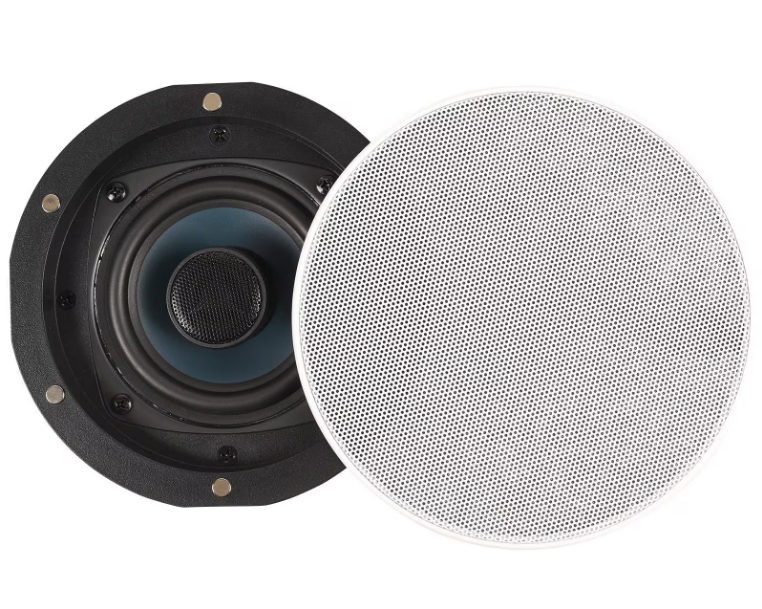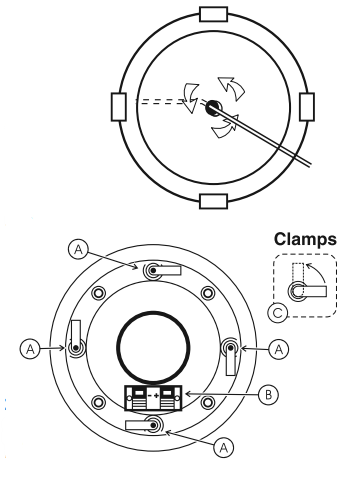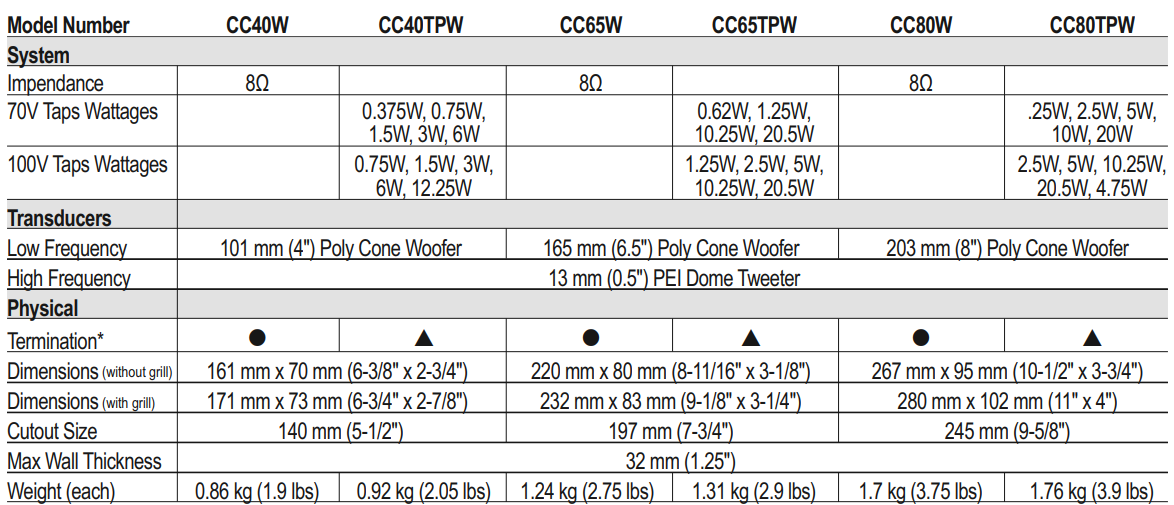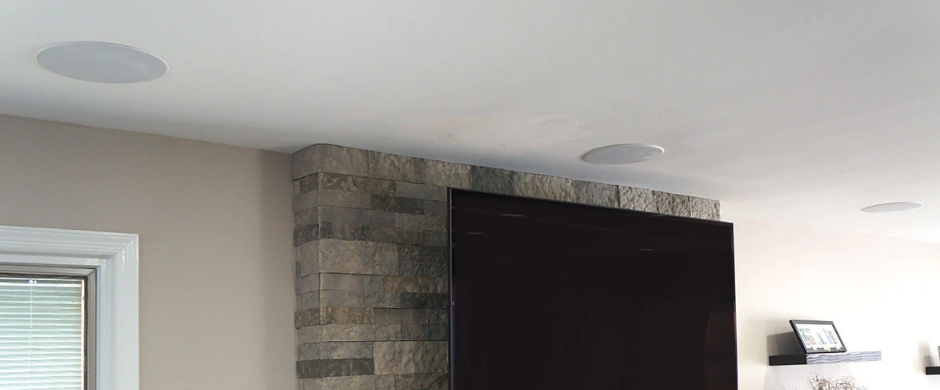
Dayton Audio CC40W Ceiling Speakers

Congratulations on the purchase of your Dayton Audio® Contractor Series Ceiling Speakers. These speakers were manufactured with high-quality components and engineered to deliver top quality sound performance.
- Long-throw polypropylene cone woofers with rubber surround
- Aimable 13 mm PEl done tweeter
Please read these instructions completely before you begin your installation.
Parts Inventory
Your speaker kit should include the following:
- 1 pair of Dayton Audio Contractor Series Ceiling Speakers with Grills
- 1 speaker installation/cutout template
Installation Tools
The Dayton Audio speakers can be installed with the following simple tools: a
- Pencil
- #2 Phillips screwdriver
- Masking tape
- Wire cutters & wire stripper/crimp tool
- Drill & drill bits
- Stud finder**
- Utility knife or wallboard saw*
* Recommended for use if installing in plaster walls.
** Optional tools to make the installation easier.
Speaker Location
To achieve the best performance from your Dayton Audio speakers, it is important to carefully select the location for installation. Your ceiling speakers should be installed 5 to 8 feet apart to ensure proper stereo imaging. Mount each speaker the same distance from the intersecting walls to maintain a uniform look. Keep the speakers at least 2 feet away from the corners of the room to avoid overemphasized bass reproduction.
Speaker Installation
Once you have selected the location for your speakers, you are ready to install them.
! CAUTION: Be certain that there are no electrical wires, water pipes, or heating ducts CAUTION: Be certain that there are no electrical wires, water pipes, or heating ducts in the planned installation area before you start drilling or cutting into the ceiling. If there is an electrical outlet nearby, turn off the circuit breaker to avoid possible injury.
Ceiling speakers are designed to be mounted in the ceiling between the joists or trusses.
Once you have selected the location, check to be sure you are between the joists or truss.
One method is to tap on the ceiling; you will hear a hollow sound when between two joists or
trusses and a sharper, more solid sound when right on top of, or close to, a joist or truss.
An easier, more accurate method for finding the location of joists or trusses is to use a stud finder.
Once you have established that your chosen location is between two joists or trusses, and that there are no obstructions in the ceiling, tape your speaker template to the ceiling and lightly trace around the inside edge with a pencil and drill a 1″ hole in the center of the template outline. Next, use a piece of stiff wire (a coat hanger works well), bend it 8″ from the end at a 90 degree angle. Insert the bent part of the coat hanger into the 1″ hole and rotate the wire in a complete circle to check for obstructions. If the wire hits a stud on either side, reposition your template to the left or right and mark the outline again. Keep the pilot hole within the template outline.
If the ceiling is made of drywall, simply cut the marked area with your utility knife or drywall saw. If the ceiling is made of plaster, you should use a saw with a higher tooth count to reduce the chance of breaking the plaster. Test fit the speaker in the hole; the speaker should fit loosely, and the speaker frame should cover the edges of the hole. Repeat these steps for the other speaker.
Speaker Cable
Don’t compromise sound quality by using thin, inexpensive speaker wire; we recommend using a high-quality oxygen-free copper speaker cable. For runs less than 50 feet, we recommend 16-gauge cable, and for longer runs, we recommend 14-gauge or larger cable. For installations with in-room stereo volume controls, we recommend using four-conductor speaker wire from the receiver to the volume controls. Most municipalities require the use of CL2-rated speaker cable for installation in walls and ceilings. Leave enough speaker cable so you can stand comfortably on the floor or ladder while connecting the speaker cable to the speakers.
Speaker Connection
Remove about 8″ of the cable jacket to expose the inner conductors. Strip 1/4″ of insulation from each conductor and connect to the speaker terminals. When connecting the wires to the speakers, be sure to observe proper polarity. Most CL2-rated speaker cables will have red and black conductors, so you will connect the red wire to the red speaker terminal and the black wire to the black speaker terminal.
For high impedance (7OV) applications, attach the positive lead from the receiver to the wattage lead on the 70V transformer to be used (i.e., 2.5W) and the negative lead from the receiver to the common ground lead (C) on the 70V transformer. For low impedance (8 ohm) applications, connect the positive lead from the receiver to the RED positive terminal on the speaker and the negative lead from the receiver to the BLACK negative terminal on the speaker.

Note: To avoid damage to the speaker, be sure to switch off the amplifier power when changing the input.
Final Installation
To install the speakers into the ceiling, remove the grills. This will give you access to the mounting screws. Turn the mounting clamps so they are positioned as in the illustration; this will allow the speakers to clear the hole for installation. Insert the speaker into the hole, and tighten the mounting screws. As you turn each screw, the mounting clamps will rotate outward to engage the ceiling material.
! CAUTION: Do Not Over-Tighten the Clamps. Too much torque may snap off the lug, and the speaker will not seat securely. A snug fit is all that is necessary to assure proper performance.
- Painting Speakers
If you choose to paint the speaker grill, do not try to paint the grill while it is on the speaker. The grill should always be painted separately. Do not apply heavy coats of paint that might block the perforations in the grill.
Troubleshooting
Should your speakers not work properly, check the following:
No sound from speakers
Most stereo receivers have an A/B speaker selector switch. Make certain that this switch is in the proper position.
- The mute feature is activated.
One speaker is playing while the other is not
- Check the balance control on the receiver. Make sure it is centered.
- Loose connection at either the receiver or the speaker. Double-check connections.
- Bad speaker cable. Replace the suspect speaker cable.
The receiver cuts on and off.
- This could be caused by a short circuit between the positive and negative leads.
Check the connections at the back of the receiver, and then at the speaker; make sure that no strands of wire from one connector are touching the other connector.
Caring For Your Ceiling Speakers
The two most common ways that ceiling speakers are permanently damaged are:
- Not enough power at higher volumes.
- Too much power at higher volumes.
Contrary to conventional wisdom, far more speakers are damaged as a result of under-powering than by overpowering. When a receiver runs out of power, it still tries to reproduce the musical signal by “clipping” the waveform. At high volume levels, this clipping introduces gross amounts of distortion to the speaker, eventually destroying it. If the sound from your ceiling speakers starts to sound distorted, turn down the volume.
Having plenty of reserve power will help your speakers reproduce dynamic contrasts and quick transients of music much more effectively, but you do have to exercise good judgment; too much power will also permanently damage a speaker. Again, if you hear distortion, turn the volume down.
Specifications

*Termination:
![]() Push Spring Terminals max wire size 14 AWG
Push Spring Terminals max wire size 14 AWG
![]() Tinned wire transformer taps
Tinned wire transformer taps
5-Year Limited Warranty
See daytonaudio.com for details.s

For more manuals by Dayton Audio, visit ManualsLibraryy
Dayton Audio CC40W Ceiling Speakers- FAQs
Q1. Are these active or passive speakers?
They are passive, so you need an external amplifier or receiver.
Q2. Do ceiling speakers need power?
They don’t plug into power; they get power from your amplifier through speaker wires.
Q3. Can they work without an amplifier?
No. Only active ceiling speakers can work without an amp.
Q4. How do I control these speakers?
Use the connected amplifier, in-wall volume controls, or a smart system if supported.
Q5. Can I connect them to my TV?
Yes, but only through an amplifier or receiver.
Q6. Do they have good bass?
Bass is limited. Adding a subwoofer gives better low-end sound.
Q7. What is the impedance?
They are 8 ohms, compatible with most home amps and receivers.
Q8. Can I use them for surround sound?
Yes, they can be used as rear, side, or height channels in a home theater.

